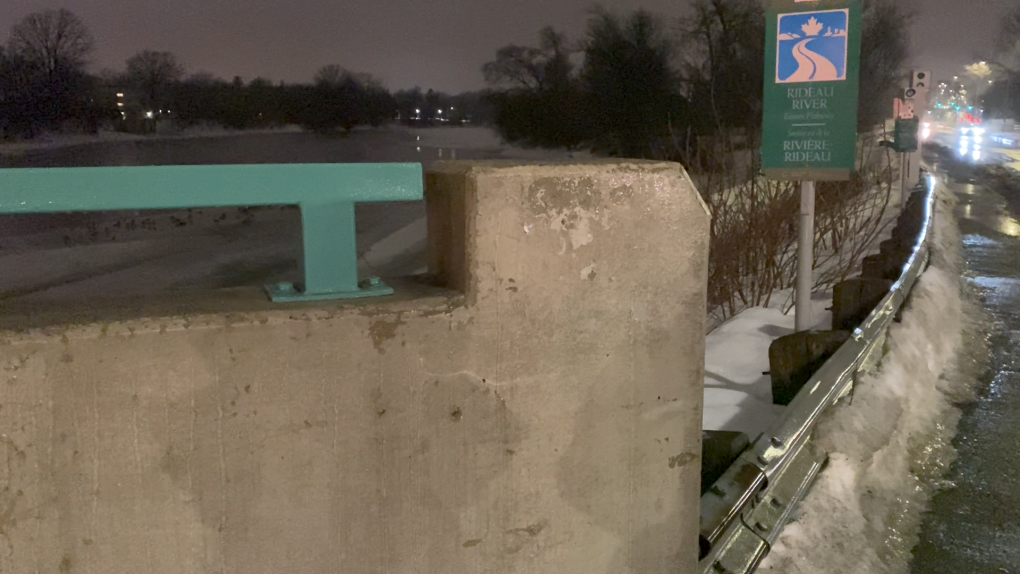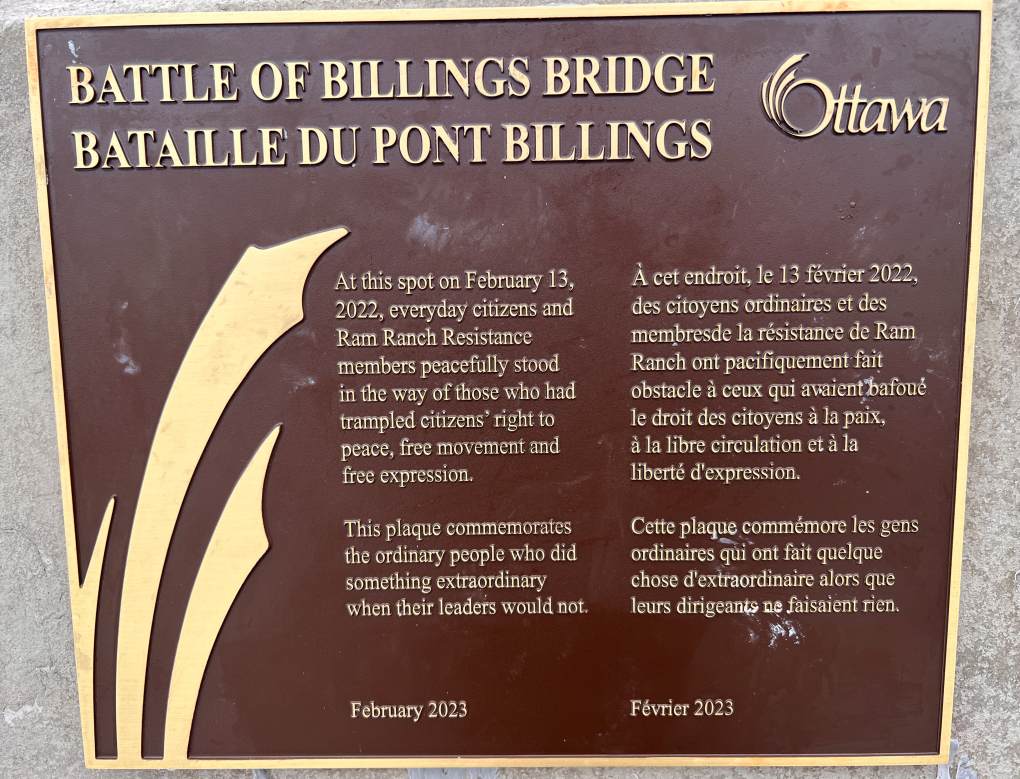Plaque commemorating 'Battle of Billings Bridge' during 'Freedom Convoy' removed
A commemorative plaque celebrating a watershed moment of citizen resistance to the 'Freedom Convoy' last year has been taken down.
The plaque commemorated the so-called 'Battle of Billings Bridge,' when hundreds of people blocked an intersection to prevent convoy protesters from driving downtown on the third weekend of the occupation.
The plaque, designed to look exactly like an official city of Ottawa plaque, was posted near Riverside Drive and Bank Street.
"At this spot on February 13, 2022, everyday citizens and Ram Ranch Resistance members peacefully stood in the way of those who had trampled citizens’ right to peace, free movement and free expression," the plaque read.
"This plaque commemorates the ordinary people who did something extraordinary when their leaders would not."
However, by late Thursday night, the plaque had been removed. A tool that appeared to have been used to remove the plaque was left at the scene.
The plaque was made of brass and glued onto the bridge with construction adhesive. It’s not clear who made it or put it up, or who removed it.
 By late Thursday night, the unofficial plaque commemorating the 'Battle of Billings Bridge' had been removed. (Natalie van Rooy/CTV News Ottawa)
By late Thursday night, the unofficial plaque commemorating the 'Battle of Billings Bridge' had been removed. (Natalie van Rooy/CTV News Ottawa)
A city spokesman confirmed Friday morning they did not remove it.
"The City of Ottawa was not responsible for the installation or the removal of the plaque mounted to Billings Bridge," said the statement attributed to Alain Gonthier the general manager of public works.
On Thursday, before the plaque was taken down, a city spokesman said it was "reviewing the matter" but did not say whether they planned to remove it.
"The City of Ottawa did not install a plaque on Billings Bridge at the Bank Street and Riverside Drive intersection and is currently reviewing the matter," a city spokesman said in a statement attributed to Dan Chenier, general manager of recreation, cultural and facility services.
The Billings Bridge protest lasted for hours and turned into a symbolic act of resistance from residents who were fed up with the convoy’s occupation of downtown.
Hundreds of volunteers, including some local politicians, gathered to block about 35 trucks that had been headed to join protesters downtown
The truck drivers were eventually allowed to leave one at a time, but only after their trucks were stripped of flags, jerry cans and any 'Freedom Convoy' paraphernalia.
Earlier Thursday, Sean Burges, a Carleton University professor whose post on Facebook the night before kickstarted the Billings Bridge protest, said he thought the plaque should stay up.
 A plaque commemorating the 'Battle of Billings Bridge' during the 'Freedom Convoy' protests erected at the bridge. The plaque is designed to look like an official city of Ottawa commemoration. (Tyler Fleming/CTV News Ottawa)
A plaque commemorating the 'Battle of Billings Bridge' during the 'Freedom Convoy' protests erected at the bridge. The plaque is designed to look like an official city of Ottawa commemoration. (Tyler Fleming/CTV News Ottawa)
“I love it. It’s an absolutely brilliant piece of guerilla protest art,” he said. “I think it would be an absolute travesty if the city came and decided to take that plaque down.”
“They don’t have credibility on this front, so they’re best just to leave it.”
Andrea Harden, who was among the first people at the protest that day, agreed.
“I think it’s brilliant. Kudos to whoever did it,” she said. “I think it was well-intentioned and a way of marking what was kind of like that first domino that led to the end of the convoy downtown.”
“I really think this speaks to the creativity of the community that was here, and a moment in time in which people were saying enough is enough, this has to end.”
Harden remembers the protest as a community coming together and taking a stand.
“The one thing that really brought so many people together on that day was this feeling of helplessness, this feeling like this occupation was happening…and a frustration that nothing was being done about it.”
Burges and Harden both said they have no idea who made the plaque. But Burges said he wants to buy them a coffee or a beer.
The plaque was installed slightly crooked, so Burges did have a suggestion for city crews.
“Maybe what the city could do is actually come and put it in properly.”
- with files from Tyler Fleming and Natalie van Rooy, CTV News Ottawa
CTVNews.ca Top Stories

opinion Tom Mulcair: Prime Minister Justin Trudeau's train wreck of a final act
In his latest column for CTVNews.ca, former NDP leader and political analyst Tom Mulcair puts a spotlight on the 'spectacular failure' of Prime Minister Justin Trudeau's final act on the political stage.
B.C. mayor gets calls from across Canada about 'crazy' plan to recruit doctors
A British Columbia community's "out-of-the-box" plan to ease its family doctor shortage by hiring physicians as city employees is sparking interest from across Canada, says Colwood Mayor Doug Kobayashi.
'There’s no support': Domestic abuse survivor shares difficulties leaving her relationship
An Edmonton woman who tried to flee an abusive relationship ended up back where she started in part due to a lack of shelter space.
Baseball Hall of Famer Rickey Henderson dead at 65, reports say
Rickey Henderson, a Baseball Hall of Famer and Major League Baseball’s all-time stolen bases leader, is dead at 65, according to multiple reports.
Arizona third-grader saves choking friend
An Arizona third-grader is being recognized by his local fire department after saving a friend from choking.
Germans mourn the 5 killed and 200 injured in the apparent attack on a Christmas market
Germans on Saturday mourned the victims of an apparent attack in which authorities say a doctor drove into a busy outdoor Christmas market, killing five people, injuring 200 others and shaking the public’s sense of security at what would otherwise be a time of joy.
Blake Lively accuses 'It Ends With Us' director Justin Baldoni of harassment and smear campaign
Blake Lively has accused her 'It Ends With Us' director and co-star Justin Baldoni of sexual harassment on the set of the movie and a subsequent effort to “destroy' her reputation in a legal complaint.
Oysters distributed in B.C., Alberta, Ontario recalled for norovirus contamination
The Canadian Food Inspection Agency has issued a recall due to possible norovirus contamination of certain oysters distributed in British Columbia, Alberta and Ontario.
New rules clarify when travellers are compensated for flight disruptions
The federal government is proposing new rules surrounding airlines' obligations to travellers whose flights are disrupted, even when delays or cancellations are caused by an "exceptional circumstance" outside of carriers' control.


































